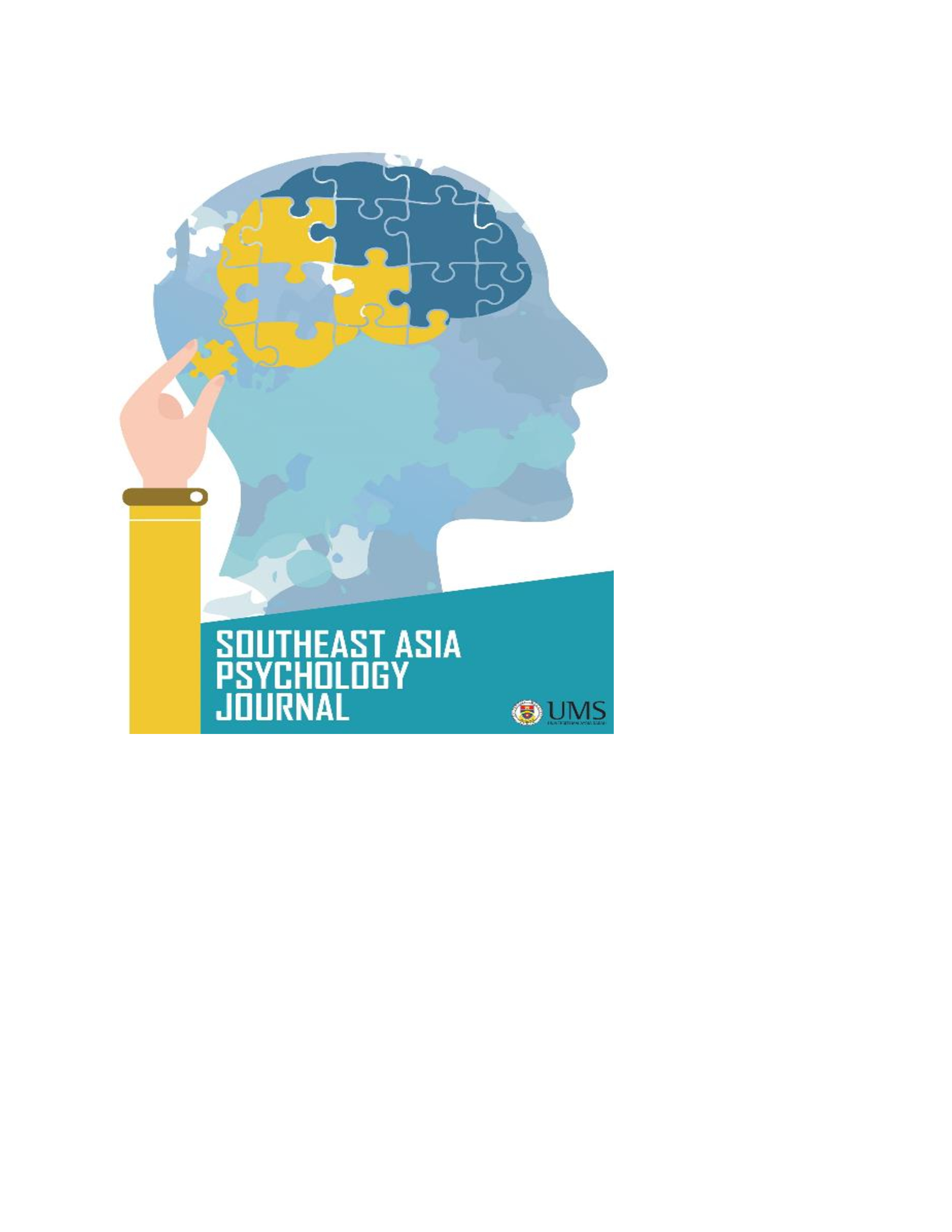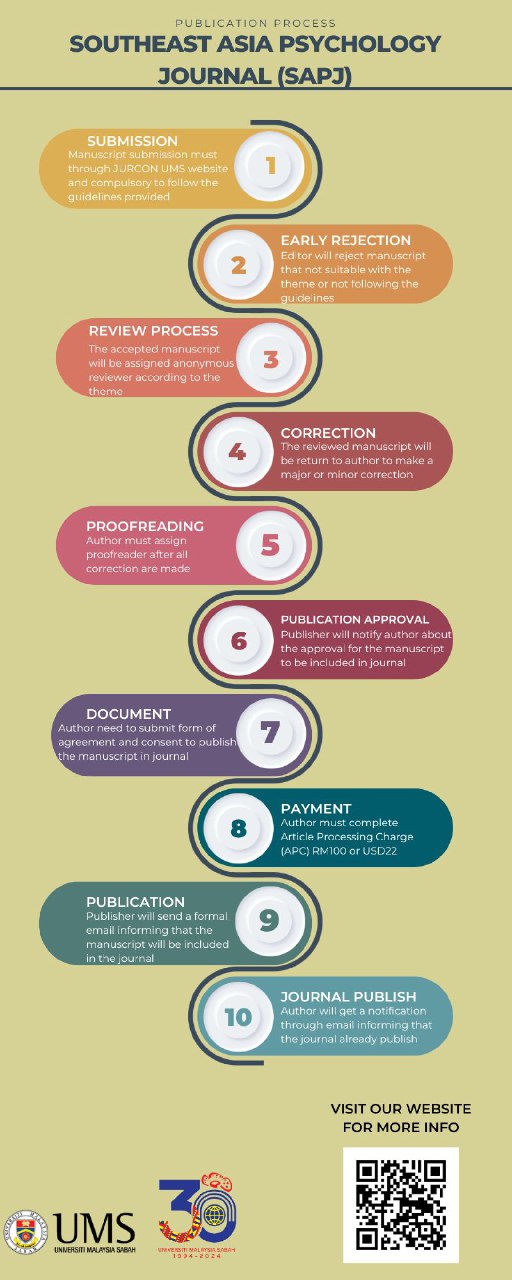PERBEZAAN GENDER DAN STATUS SOSIOEKONOMI TERHADAP KEBIMBANGAN BAHASA ASING DALAM KALANGAN PELAJAR UNIVERSITI AWAM DI SABAH
DOI:
https://doi.org/10.51200/sapj.v11i2.4910Keywords:
Foreign Language Anxiety, University Students, Gender, Socioeconomic StatusAbstract
This study was conducted to identify the level of foreign language anxiety (FLA), gender differences,
and socioeconomic status influence on FLA among public university students in Sabah. The research was
carried out at Universiti Malaysia Sabah (UMS) and Universiti Teknologi Mara (UiTM) branch in Kota
Kinabalu, Sabah. A total of 358 respondents, consisting of 104 males and 254 females, participated in this
study. The research adapted the Foreign Language Classroom Anxiety Scale (FLCAS) questionnaire developed
by Horwitz, Horwitz, and Cope (1986). Data analysis was performed using the Statistical Package for Social
Science (SPSS) version 28.0. The study results indicated that the level of FLA among public university students
in Sabah is at a moderate level. The study also showed gender differences in FLA among male and female
students (p < .05), where female students (M = 97.97, SD = 20.88) exhibited higher levels of FLA compared to
male students (M = 91.22, SD = 20.09). Furthermore, the study revealed socioeconomic status differences in
FLA among public university students in Sabah (p < .05). The findings showed that students from low
socioeconomic status were reported to have high levels of FLA (M = 97.72, SD = 21.02). On the other hand,
students from high socioeconomic status had lower levels of FLA (M = 83.63, SD = 16.79). The findings of this
study can provide a deeper understanding and clarity for students, parents, and educators regarding the issue of
FLA that often occurs among students. Suggestions for future research include expanding the scope of locations
and study samples, diversifying data collection methods, and conducting longitudinal studies.
References
Abbasian, R., Hadian, B. & Vaez-Dalili, M. (2020). Exploring the interplay between Iranian EFL
learners’ first language (L1) literacy resources and their performance on L2 receptive skills.
Current Psychology, 39, 1900–1909. https://doi.org/10.1007/s12144-018-0059-5
Abu-Rabia, S. (2004). Teachers’ role, learners’ gender difference and FL anxiety among seventhgrade
students studying English as FL. Educational Psychology, 24, 711–729.
http://dx.doi.org/10.1080/0144341042000263006
Afandi Yusoff., Nik Mohd Rahimi Nik Yusoff., & Harun Baharuddin. (2019). Kebimbangan bahasa
dan hubungannya dengan pencapaian dalam Bahasa Arab. Jurnal Pendidikan Malaysia,
(2), 1–9. http://dx.doi.org/10.17576/JPEN-2019-44.02-01
Aida, Y. (1994). Examination of Horwitz, Horwitz, and Cope's construct of foreign language anxiety:
The case of students of Japanese. The modern language journal, 78(2), 155–168.
http://dx.doi.org/10.1111/j.1540-4781.1994.tb02026.x
Akhtar, Z., & Niazi, H. K. (2011). The relationship between socioeconomic status and learning
achievement of students at secondary level. International Journal of Academic Research,
(2), 956–962.
Allen M., Titsworth, S., & Hunt S. K. (2009). Quantitative Research in Communication. California:
SAGE Publications, Inc.
Alnahidh, F. & Altalhab, S. (2020). The level and sources of foreign language speaking anxiety
among Saudi EFL university students. Advances in Language and Literary Studies, 11(1), 55–
Alsalooli, R. A., & Al-Tale’, M. A. (2022). Saudi EFL learners’ FLA: Levels, causes, gender, and
impact on academic performance. Journal of Language Teaching and Research, 13(1),145–
https://doi.org/10.17507/JLTR.1301.17
Altschul, I. (2012). Linking socioeconomic status to the academic achievement of Mexican American
youth through parent involvement in education. Journal of the Society for Social Work and
Research, 3(1), 13–30.
Ariani, M. G., & Ghafournia, N. (2016). The relationship between socio-economic status, general
language learning outcome, and beliefs about language learning. International Education
Studies, 9(2), 89–96.
Arnaiz, P., & Guillén, F. (2012). Foreign language anxiety in a Spanish university setting:
Interpersonal differences. Revista de Psicodidáctica, 17(1), 5–26.
Awan, R., U., N., Azher, M., Anwar, M., N., & Naz, A. (2010). An investigation of foreign language
classroom anxiety and its relationship with students’ achievement. Journal of College
Teaching & Learning, 7(11), 33–40.
Batumlu, D. Z., & Erden, M. (2007). The relationship between foreign language anxiety and English
achievement of Yildiz technical university school of foreign languages preparatory students.
Journal of theory and practice in education, 3(1), 24–38.
Bensoussan, M., & Zeidner, M. (1989). Anxiety and achievement in a multicultural situation: The oral
testing of advanced English reading comprehension. Assessment and Evaluation in Higher
Education, 14(1), 40–54.
Berhane, G. & Deepanjali, M. (2019). Foreign language anxiety among Ethiopian University EFL
students. International Journal of Innovative Technology and Exploring Engineering (IJTEE),
(7c), 43–48.
Brown, H. D. (2000). Principles of Language Learning and Teaching (4th ed.). White Plains, NY:
Pearson Education.
Burstall, C. (1975). Factors affecting foreign-language learning: A consideration of some relevant
research findings. Language Teaching and Linguistic Abstracts, 8, 105–125.
Carroll, S. R. (2010). The relationship of math anxiety and mathematics comprehension in middle
school students. Thesis: Walden University.
Chen, T. Y., & Chang, G. B. (2004). The relationship between foreign language anxiety and learning
difficulties. Foreign Language Annals, 37(2), 279–289.
Cheng, Y. (2002). Factors associated with foreign language writing anxiety. Foreign Language
Annals, 35, 647–656.
Chiu, M. M., & McBride-Chang, C. (2010). Family and reading in 41 countries: Differences across
cultures and students. Scientific Studies of Reading, 14, 514–543.
Creswell, J. W. (2012). Educational research planning, conducting, and evaluating quantitative and
qualitative research (4th ed.). Boston, MA: Pearson Education Inc.
Dewaele, J.-M., & Ip, T. S. (2013). The link between foreign language classroom anxiety, second
language tolerance of ambiguity and self-rated English proficiency among Chinese learners.
Studies in Second Language Learning and Teaching, 3(1), 47–66.
Eamon, M. K. (2005). Social-demographic, school, neighborhood, and parenting influences on
academic achievement of Latino young adolescents. Journal of Youth and Adolescence, 34,
–175. http://dx.doi.org/10.1007/s10964-005-3214-x
Ebel, R. L. (1980). Survey research in education: The need and the value. Peabody Journal of
Education, 57(2), 126–134. http://dx.doi.org/10.1080/01619568009538278
Edgar, T. W., & Manz, D. O. (2017). Research methods for cyber security. Massachusetts, US:
Syngress Publishing.
Elkhafaifi, H. (2005). Listening comprehension and anxiety in the Arabic language classroom. The
Modern Language Journal, 89(2), 206–220.
Ergun, E. (2011). An investigation into the relationship between emotional intelligence and foreign
language anxiety of students at a private university. Thesis: Middle East Technical
University, Turkey.
Escarce J. J. (2003). Socioeconomic status and the fates of adolescents. Health services research,
(5), 1229–1233. https://doi.org/10.1111/1475-6773.00173
Ezzi, N. A. A. (2012). The impact of gender on the foreign language anxiety of the Yemeni university
students. International Journal of Applied Linguistics & English Literature, 1(2), 65–75.
http://dx.doi.org/10.7575/ijalel.v.1n.2p.65
Frechette, J. A. D. (2013). Understanding the home literacy environment of a low-income urban
community. Thesis: University of Rhode Island.
Gerencheal, B. (2016). Gender differences in foreign language anxiety at an Ethiopian university:
Mizan-Tepi University third-year English major students in focus. African Journal of
Education and Practice, 1(1), 1–16.
Graetz, B. (1995). Socio-economic status in education research and policy. In J. G. Ainley and
Australian Council for Educational Research (Eds.), Socio-economic Status and School
Education. Australia: AGPS Press Publication.
Hochschild, J. L. (2003). Social class in public schools. Journal of Social Issues, 59(4), 821–840.
Horwitz, E. K., & Young, D. J. (1991). Language Anxiety: From Theory and Research to Classroom
Implications. Englewood Cliffs, NJ: Prentice Hall.
Horwitz, E. K., Horwitz, M. B., & Cope, J. (1986). Foreign language classroom anxiety. The Modern
language journal, 70(2), 125–132. https://doi.org/10.1111/j.1540-4781.1986.tb05256.x
Horwitz, E. K., Tallon, M., & Luo, H. (2010). Foreign language anxiety. In J. C. Cassady (Ed.),
Anxiety in schools: The causes, consequences, and solutions for academic anxieties (pp. 95–
. New York, NY: Peter Lang.
Intan Raihana Rosle., & Mohd Syuhaidi Abu Bakar. (2022). Kesan filem-filem tayangan di Netflix
terhadap masyarakat di Malaysia semasa pandemik Covid-19. Borneo Akademika, 6(1), 1–11.
Jeynes, W. H. (2002). Examining the effects of parental absence on the academic achievement of
adolescents: The challenge of controlling for family income. Journal of Family and Economic
Issues, 23(2), 189–210.
Kalaycıoğlu, B. K. (2015). The influence of socioeconomic status, self-efficacy, and anxiety on
Mathematics achievement in England, Greece, Hong Kong, the Netherlands, Turkey, and the
USA. Educational Sciences: Theory & Practice, 15(5), 1391–1401.
Kamal Badrasawi., Abdulateef Solihu., & Badariah Ahmad. (2020). Second language speaking
anxiety among Malaysian postgraduate students at a Faculty of Education. International
Journal of Education and Literacy Studies, 8(2), 54–61.
Kirby, J. R., & Hogan, B. (2008). Family literacy environment and early literacy development.
Exceptionality Education International, 18(3), 112–130.
Kitano, K. (2001). Anxiety in the college Japanese language classroom. The Modern Language
Journal, 85, 549–566.
Krashen, S. D. (1982). Principles and practice in second language acquisition. Oxford: Pergamon
Press.
Krejcie, R. V., & Morgan, D. W. (1970). Determining sample size for research activities. Educational
and Psychological Measurement, 30(3), 607–610.
Lu, Z., & Liu, M. (2015). An investigation of Chinese university EFL learner’s foreign language
reading anxiety, reading strategy use and reading comprehension performance. Studies in
Second Language Learning and Teaching, 5(1), 65–85.
MacIntyre, P. D. (1999). Language anxiety: A review of the research for language teachers. In D. J.
Young (Ed.), Affect in Foreign Language and Second Language Learning: A Practical Guide
to Creating a Low-Anxiety Classroom Atmosphere (pp. 24–45). Boston: McGraw-Hill.
MacIntyre, P. D. (2017). An overview of language anxiety research and trends in its development. In
C. Gkonou, M. Daubney, & J. M. Dewaele (Eds.), New Insights into Language Anxiety:
Theory, Research and Educational Implications (pp. 11–30). Bristol: Multi-lingual Matters.
MacIntyre, P. D., & Gardner, R. C. (1989). Anxiety and second‐language learning: Toward a
theoretical clarification. Language learning, 39(2), 251–275.
Martorana, J. M. (2015). Parent involvement and literacy achievement: A case study. Thesis: State
University of New York.
Marwan, A. (2016). Investigating students’ foreign language anxiety. Malaysian Journal of ELT
Research, 3(1), 19.
Mattheoudakis, M., & Alexiou, T. (2009). Early foreign language instruction in Greece:
Socioeconomic factors and their effect on young learners’ language development. In M.
Nikolov (Ed.), The Age Factor and Early Language Learning (pp. 227–252). Berlin, NY: De
Gruyter Mouton. http://dx.doi.org/10.1515/9783110218282.227
McNeal, R. B. (2001). Differential effects of parental involvement on cognitive and behavioral
outcomes by socioeconomic status. Journal of Socio-Economics, 30(2), 171.
Muhammad Hazrul Ismail. (4–6 Jun 2012). Kajian mengenai kebolehpasaran siswazah di Malaysia:
Tinjauan dari perspektif majikan. Persidangan Kebangsaan Ekonomi Malaysia ke VII
(PERKEM VII) (pp. 906–913). Ipoh, Perak: Universiti Kebangsaan Malaysia.
Noor Adawiyah Ahmad Radzi., Roslida Saat., & Norainee Idris. (2021). Tahap keresahan terhadap
mata pelajaran bahasa asing dalam kalangan pelajar Kolej Universiti Islam Melaka. Jurnal
‘Ulwan, 6(3), 179–188.
Öztürk, G., & Gürbüz, N. (2013). The impact of gender on foreign language speaking anxiety and
motivation. Procedia – Social and Behavioral Sciences, 70, 654–665.
Pace, A., Luo, R., Hirsh-Pasek, K., & Golinkoff, R. M. (2017). Identifying pathways between
socioeconomic status and language development. Annual Review of Linguistics, 3, 285–308.
Pappamihiel, N. E. (2001). Moving from the ESL classroom into the mainstream: An investigation of
English language anxiety in Mexican girls. Bilingual Research Journal, 25(1), 31–38.
Pappamihiel, N. E. (2002). English as a second language students and english language anxiety:
Issues in the mainstream classroom. Research in the Teaching of English, 36, 329–355.
Park, G. P., & French, B. F. (2013). Gender differences in the foreign language classroom anxiety
scale. System, 41, 462–471.
Piechurska-Kuciel, E. (2012). Gender-dependent language anxiety in polish communication
apprehensive. Studies in Second Language Learning and Teaching, 2(2), 227–248.
Ramiza Darmi., & Peter Albion. (9-10 June 2014). Asssessing the language anxiety of Malaysian
undergraduate English language learners. Global Conference on Language Practice &
Information Technology 2014 (Glit 2014) (pp. 1–10). Kota Kinabalu, Sabah: Novotel Hotel.
Sankueana, W., & Sucaromana, U. (14-15 July 2018). Foreign language classroom anxiety of Thai
high school students. 11th International Conference on Language, Literature, Culture &
Education (pp. 57–65). Bangkok: International Conference on Systems and Informatics.
Shamim, F. (2011). English as the language for development in Pakistan: Issues, challenges and
possible solutions. In H. Coleman (Ed.), Dreams and realities: Developing countries and the
English language (pp. 291–310). London: British Council.
Shi, Y. Z., & Liu, Z. Q. (2006). Foreign language reading anxiety and its relationship to English
achievement and gender. Journal of PLA University of Foreign Languages, 29(2), 59–64.
Siew, P. W., & Wee, K. P. (2017). Gender differences in speaking anxiety among English as a second
language learners in a Malaysian tertiary context. International Journal for Studies on
Children, Women, Elderly and Disabled, 2, 108–117.
Subatira Balakrishnan., Nurlisa Loke Abdullah., & Mei Sui Linda Khoo. (2020). English language
learning anxiety and its relationship with language achievement: A study on learners in a
technical university. Journal of Technical Education and Training, 12(3), 161–170.
Tercan, G., & Dikilitaş, K. (2015). EFL students’ speaking anxiety: A case from tertiary level
students. International Association of Research in Foreign Language Education and Applied
Linguistics ELT Research Journal, 4(1), 16–27.
Thompson, A. S. (2008). Prominent factors in the acquisition of Portuguese: Language aptitude versus
previous language experience. Selected Proceedings of the 10th Hispanic Linguistics
Symposium (pp. 134–145). Somerville, MA: Cascadilla Proceedings Project.
Tsai, C. C. (2013). The impact of foreign language anxiety, test anxiety, and self-efficacy among
senior high school students in Taiwan. International Journal of English Language and
Linguistics Research, 1(3), 1–17.
Wan Zarina Wan Zakaria, Azizah Rajab, NorFazila Sayuti, & Nur Al-Huda Hashim. (2007). Kajian
tahap keresahan di kalangan pelajar bahasa asing terhadap mata pelajaran bahasa asing.
Universiti Teknologi Malaysia: Pusat Pengurusan Penyelidikan.
Williams, J. M. (2011). Home, school, and community factors that contribute to the educational
resilience of urban, African American high school graduates from low income, single-parent
families. Doctoral dissertation: University of Lowa.
Williams, K. (1991). Anxiety and formal second/foreign language learning. RELC Journal, 22(2), 19–
http://dx.doi.org/10.1177/003368829102200202
Wimmer, R. D., & Dominick, J. R. (2003). Mass media research. Belmont, CA: Wadsworth.
Yeo, J. Y., Vicky, C., & Ting, H. L. (2017). The role of gender in English language learning anxiety
among tertiary students. e-Academia Journal, 6(2), 14–22.








